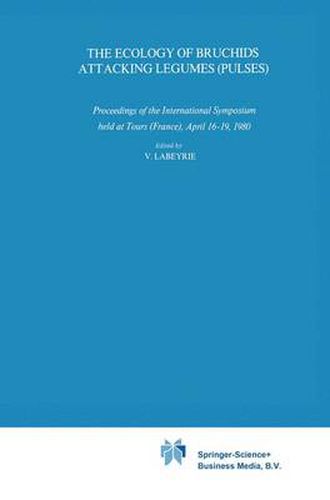Readings Newsletter
Become a Readings Member to make your shopping experience even easier.
Sign in or sign up for free!
You’re not far away from qualifying for FREE standard shipping within Australia
You’ve qualified for FREE standard shipping within Australia
The cart is loading…






This title is printed to order. This book may have been self-published. If so, we cannot guarantee the quality of the content. In the main most books will have gone through the editing process however some may not. We therefore suggest that you be aware of this before ordering this book. If in doubt check either the author or publisher’s details as we are unable to accept any returns unless they are faulty. Please contact us if you have any questions.
As editor of this volume I am not going to emphasize the economic im portance of the Bruchids of pulses, nor how necessary it is to know the conditions of infestation of crops in order to achieve an efficient protection; both points are testified by F.A.O.‘s sponsorship, as well as of the International Organization for Biological Control. On the other hand I would like to stress the scientific interest of the study of 'domestic’ bruchids. It raises questions which require that present basic entomological knowledge be extended. I am not going to review all questions raised but I will emphasize those I am most aware of. Some bruchid species have been able to colonize habitats differing totally; some differing in their latitude, and thus their basic periodicities; others differing in their degree of complexity (stocks of seeds): What are the respective roles played by polymorphism and plasticity in that exceptional capacity? What differences are there between the populations living on wild plants in dispersal areas and those living in stocks? What are the alterations brought about by the drastic selection pressures in populations having later colonized habitats ecologically similar to the original habitats? What factors determine the degree of specificity of trophic relationships, and the possibilities of extension of the niche? What influences are exerted by the other elements of the original bio cenoses upon the behavioural evolution of these species? Such are a few fundamental problems that can be tackled directly through
$9.00 standard shipping within Australia
FREE standard shipping within Australia for orders over $100.00
Express & International shipping calculated at checkout
This title is printed to order. This book may have been self-published. If so, we cannot guarantee the quality of the content. In the main most books will have gone through the editing process however some may not. We therefore suggest that you be aware of this before ordering this book. If in doubt check either the author or publisher’s details as we are unable to accept any returns unless they are faulty. Please contact us if you have any questions.
As editor of this volume I am not going to emphasize the economic im portance of the Bruchids of pulses, nor how necessary it is to know the conditions of infestation of crops in order to achieve an efficient protection; both points are testified by F.A.O.‘s sponsorship, as well as of the International Organization for Biological Control. On the other hand I would like to stress the scientific interest of the study of 'domestic’ bruchids. It raises questions which require that present basic entomological knowledge be extended. I am not going to review all questions raised but I will emphasize those I am most aware of. Some bruchid species have been able to colonize habitats differing totally; some differing in their latitude, and thus their basic periodicities; others differing in their degree of complexity (stocks of seeds): What are the respective roles played by polymorphism and plasticity in that exceptional capacity? What differences are there between the populations living on wild plants in dispersal areas and those living in stocks? What are the alterations brought about by the drastic selection pressures in populations having later colonized habitats ecologically similar to the original habitats? What factors determine the degree of specificity of trophic relationships, and the possibilities of extension of the niche? What influences are exerted by the other elements of the original bio cenoses upon the behavioural evolution of these species? Such are a few fundamental problems that can be tackled directly through